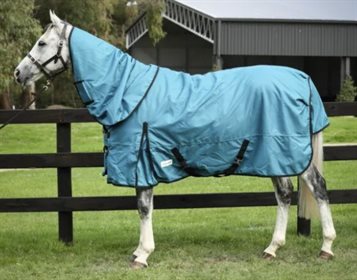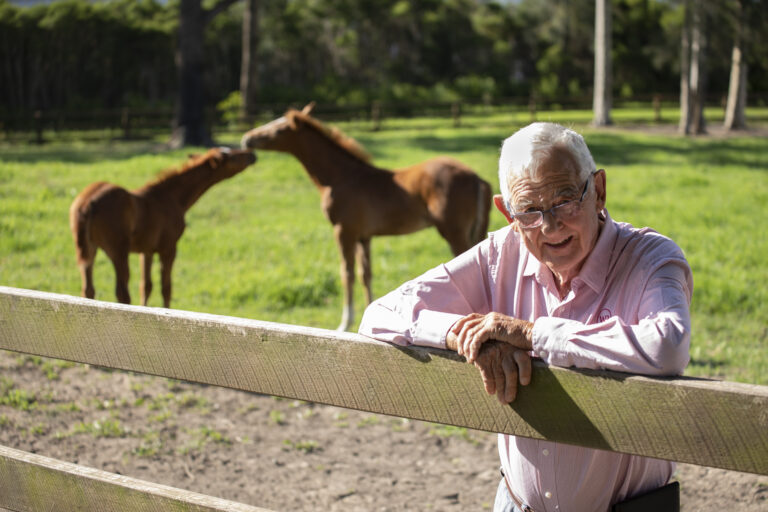Goodwoods 1200 denier detacher neck with 220 gram fill. RRP $169.95, sale $67.00.
Nine tips for rugging your horse this winter
If you’re planning to rug your horse this winter, here are a few tips to remember:
1. Make sure the rugs fit correctly
Ensuring your rugs are properly fitted to each horse is important to prevent injury or accidental rubbing. These injuries, if they occur, can take weeks to months to repair; therefore, taking the time to ensure that rugs fit correctly is well worth the effort. The use of bibs can reduce rubbing on the shoulder regions and can be padded to provide pressure relief around the withers, especially if the horse has a very prominent wither.
Need a better fit? Check out Goodwoods’ Winter Rug Warehouse Clearance and save!
2. Always check on your horse
It is important to periodically take off the rugs to check that there are no issues going on underneath. Check frequently for signs of rubbing or skin irritations, injury and also body condition – the last of particular importance for older horses and those prone to weight loss. Frequent checking will also pick up any minor mane loss caused by neck rugs, giving you the opportunity to take action before it progresses too far.
3. Be aware of skin conditions
Keeping the rugs and your horse clean is essential to prevent skin infections from developing; take particular care if rugs are put onto wet horses or if horses are left sweating in rugs for long periods of time, as wet skin under warm rugs is a recipe for fungal and bacterial skin diseases. As per the last point, be sure to check underneath rugs frequently so that any developing skin conditions can be treated before they become a serious problem.

Goodwoods 600 denier synthetic winter combo with 180 gram fill. RRP $134.95, sale $53.00.
4. Just because you feel cold doesn’t mean your horse is
How many times have you thrown an extra rug on your horse because you’re a bit chilly? We’ve all done it! However, just because you’re feeling the cold doesn’t necessarily mean your horse is too.
This is because horses and humans have different thermoneutral zones (TNZ) – that is, the ambient temperature range in which we can maintain our normal body temperature without needing to use energy beyond a normal basal metabolic rate. For humans, this range is approximately 25-30 degrees Celsius, while in horses the TNZ is 5-25 degrees Celsius (noting that rain and wind chill can affect the TNZ). This means we humans feel cold well before our horses do – and horses are likely to feel a bit hot before we do.
So what does this mean in terms of rugging? In short, it means don’t over rug. Down south the weather can certainly get pretty chilly – but we’re no Antarctica.

Soft shell unlined 14oz canvas combo. RRP $89.95, sale $30.00.
5. Ears and legs are not a reliable indication of internal temperature
How do you know if your horse is the right temperature under his rug? Feeling the ears or legs is not a reliable indicator of how warm your horse is; the best way to check is to place your hand under the rug, just behind the withers. Does your horse feel cold? Is he hot and/or sweaty? Or does he feel comfortably warm?

6. Not the only way to keep warm
If the weather has worsened but you’re unable to adequately monitor the addition of extra rugs, remember there are other ways to keep horses warm. In addition to the obvious things such as providing physical shelter, the process of digesting roughage warms a horse from the inside out. Giving your horse extra roughage on cold days will help keep them warm, as the digestion and fermentation of hay produces heat that helps the horse maintain its body temperature. It’s important to note that grains simply don’t produce the same amount of body heat when digested compared to hay and hay alternatives.
7. Clipped horses require more rugging
As mentioned earlier, if you’re clipping your horse, you are removing his natural coat and with it some of his ability to thermoregulate. Therefore, clipped horses need more rugs; often, a layering system works well, for example, a cotton sheet followed by a woollen or fleece blanket and a top turnout rug. However, once you start adding more rugs you do need to make sure you’re monitoring your horse’s temperature regularly and adjusting as required – a clipped horse can still get too hot.
Find the right rugs for your horse at up to 60% off with Goodwoods’ Winter Rug Warehouse Clearance.
8. Not all horses are the same
You can’t assume that every horse in the paddock will be fine in the same rug at the same time. The truth is, some horses run hotter or colder than others. Some might be overweight and able to expend a little more energy on thermoregulation without it negatively impacting their condition, while others might struggle to maintain their weight in cold weather. For example, a horse with Cushings will often have a long, woolly coat and is also likely to have trouble regulating its body temperature; these horses may be more likely to sweat up under heavy rugs and therefore need to be monitored more closely.
Get to know your horse and feel them regularly under their rug in a range of conditions – you’ll soon know the type of rug required to keep them comfortable.

Goodwoods 1680 denier combo with 250 gram fill. RRP $189.95, sale $75.00.
9. Don’t weigh down horses to maintain their weight
Horses that struggle to maintain their weight in the cooler months – especially older horses – need to be rugged adequately to ensure they are not expending energy on keeping warm. However, in ensuring these types of horses are kept warm enough, we must make sure they are a) not too hot, because that’s also not good for them, and b) not carrying too much weight.
If you’ve ever dragged rugs off your horse and struggled to throw them over the fence rail, you’ll know that serious rugging can lead to serious weight – especially if the rugs have become waterlogged. For a horse struggling to maintain condition, lugging around heavy rugs can work against the benefit of keeping them warm. Now this is not to say they shouldn’t be rugged – but rather we should pay attention to the type of rugs being used. Aim for rugs that are warm yet relatively light in terms of weight, and ensure they are thoroughly water repellent, as rugs become much heavier when they retain water.
Read more about rugging your horse in the May 2023 issue of Equestrian Life magazine.
READ THE LATEST NEWS ARTICLES HERE








